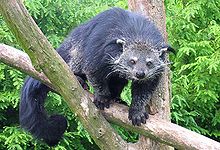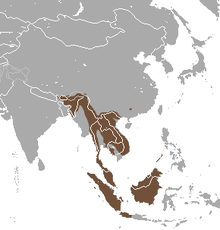Binturong
| Binturong | |
|---|---|
 |
|
| Scientific classification | |
| Kingdom: | Animalia |
| Phylum: | Chordata |
| Class: | Mammalia |
| Order: | Carnivora |
| Family: | Viverridae |
| Subfamily: | Paradoxurinae |
| Genus: |
Arctictis Temminck, 1824 |
| Species: | A. binturong |
| Binomial name | |
|
Arctictis binturong (Raffles, 1822) |
|
 |
|
| Binturong range | |
The binturong (/bɪnˈtuːrɒŋ/ bin-TOO-rong) (Arctictis binturong), also known as bearcat, is a viverrid native to South and Southeast Asia. It is uncommon in much of its range, and has been assessed as vulnerable on the IUCN Red List because of a declining population trend that is estimated at more than 30% over the last three decades.
Despite being called 'bearcat' this carnivorous mammal is neither closely related to bears nor cats, but to the palm civets of Asia. It is a monotypic genus. Its genus name Arctictis means ‘bear-weasel’, from Greek ‘bear’ + ‘weasel’.
In 1822, Thomas Stamford Raffles first described a specimen from Malacca. In Riau, Indonesia it was known as tenturun.
The body of the binturong is long and heavy, with short, stout legs. It has a thick fur of strong black hair. The bushy and prehensile tail is thick at the root, gradually diminishing in size to the extremity, where it curls inwards. The muzzle is short and pointed, somewhat turned up at the nose, and is covered with bristly hairs, brown at the points, which lengthen as they diverge, and form a peculiar radiated circle round the face. The eyes are large, black and prominent. The ears are short, rounded, edged with white, and terminated by tufts of black hair. There are six short rounded incisors in each jaw, two canines, which are long and sharp, and six molars on each side. The hair on the legs is short and of a yellowish tinge. The feet are five-toed, with large strong claws; the soles are bare, and applied to the ground throughout the whole of their length; the hind ones are longer than the fore.
...
Wikipedia

